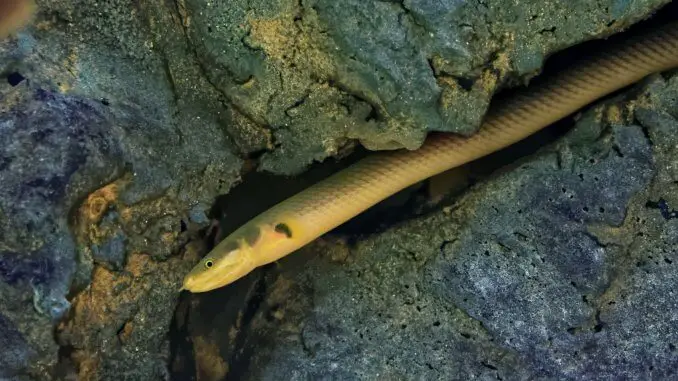
With its eel-like appearance, the rope fish attracts those who want a change from ‘normal’ fish.
They’re peaceful carnivores that get on well with other large, peaceful fish. This makes them great for both species-only tanks and community aquariums.
Though they’re not the most colorful species, adding rope fish changes the dynamics of a tank with their unique appearance and behaviors.
Their appearance can scare people away as they assume they must be hard to care for. This is not true. Although a little bit of experience is useful, this is an undemanding species that is relatively easy to care for.
This article covers all aspects of rope fish care, including their appearance, diet, ideal setups, and much more…
TABLE OF CONTENTS
Rope Fish Facts & Overview
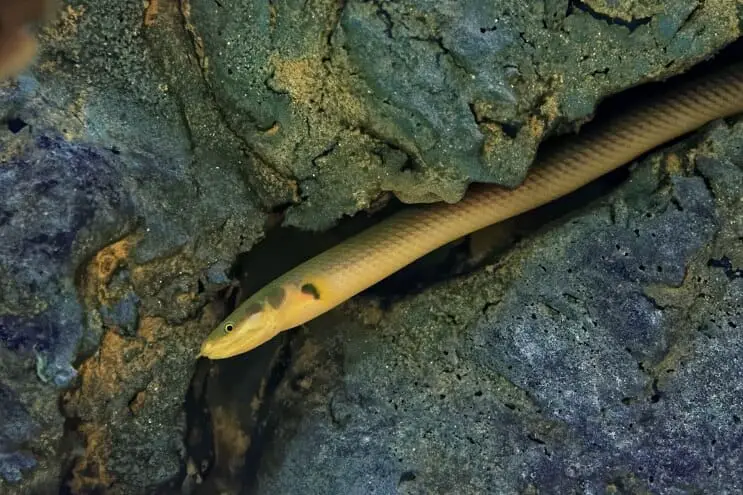
| Category | Rating |
| Care Level: | Easy |
| Temperament: | Peaceful |
| Color Form: | Greenish-brown with yellow fins |
| Lifespan: | 15-20 years |
| Size: | Up to 15 inches |
| Diet: | Carnivore |
| Family: | Polypteridae |
| Minimum Tank Size: | 45 gallons |
| Tank Set-Up: | Freshwater with sand and caves |
| Compatibility: | Large, peaceful fish |
Rope fish are known under a few different names, including Reed Fish, Snake Fish, African Rope Fish, and their Latin name Erpetoichthys calabaricus. They belong to the Polypteridae family and are a freshwater species living in slow-moving rivers across West and Central Africa.
They can be found in Benin, Cameroon, the Republic of the Congo, and Nigeria.
As you can guess from its name, this fish has a long body resembling an eel. This draws people who are looking for more exotic pets since there aren’t many fish that share this body.
They are not to be kept lightly though. People often don’t realize that they can live for 15-20 years in captivity, far longer than most species in the aquarium trade.
If you design their environment properly and keep it clean, then they’re fairly easy to keep and care for. Choosing the right tank mates is crucial because rope fish are predators and will likely eat smaller fish (more on this later).
Young juveniles can be found for $10, with larger adults costing $20 or more.
Typical Behavior
You may find that they are more active at night than in the wild they would hunt at night and sneak up on their prey. However, if you feed them during the daytime, they will eventually become more active throughout the day.
They spend most of their time in the lower levels of the aquarium. They may head up to the surface to breathe since they have both gills and primitive lungs. You only tend to see this behavior in oxygen-poor environments.
It is interesting to watch as they move around the tank. Their body bends into waves like an eel to create thrust which helps them move.
Rope fish aren’t an aggressive species and you generally won’t see them attacking tank mates. The only exception is smaller fish might be eaten after being mistaken for food.
One thing to watch out for is their ability to jump.
Appearance
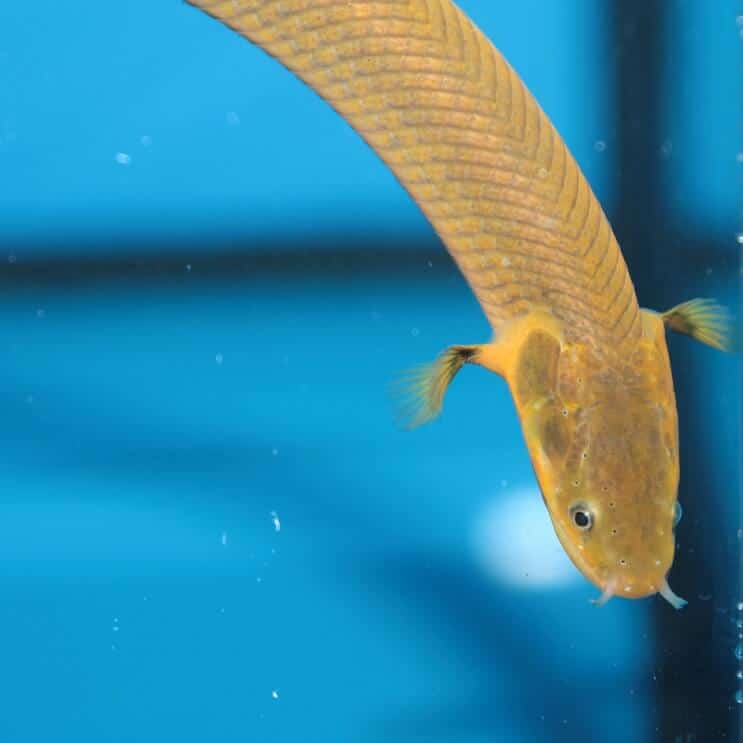
They look like ropes, snakes, and reeds, which is why their names haven’t needed to be too imaginative.
It’s their distinct appearance that makes them such exotic fish.
They have a long cylindrical body that reaches lengths of up to 15 inches. If you haven’t done your research then their size can take you by surprise, so make sure your tank is big enough.
Their whole body is covered in diamond-shaped scales with a brown/green color; this helps them blend into dark areas.
Fins are either reduced or absent. They are not too important for movement since their body can be manipulated into waves for thrust. These waves even allow movement on land, like a snake.
The pectoral fins are small in relation to the body. They look a little out of place because they’re yellow and positioned right behind the head. There is a dorsal fin, but it can be hard to spot. It has 9-14 rays but they are usually kept flat against the body.
Ventral and caudal fins are essentially non-existent, though you could argue that the body is one giant caudal fin.
Males and females look similar, so you’ll struggle to tell them apart when trying to mate them. It has been suggested that males have more rays on their dorsal fin. This isn’t very reliable though because it’s hard to count the rays in the first place.
Habitat and Tank Conditions
Though they look very different to most fish, rope fish live in similar environments to other common fish species. The natural habitat for rope fish would be brackish/fresh water in tropical areas. They are usually found in rivers such as the Ogun River in Nigeria.
These areas have warm water with a neutral pH, perhaps slightly alkaline. Water movement would be low but plenty of light would be available.
You would find plenty of debris along the riverbed such as rocks and bogwood. These create crevices for the fish to hide between until nighttime.
They are also found in low oxygen environments; they can survive here because of their primitive lungs.
Tank Setup
It shouldn’t be a challenge to set up the perfect tank.
Cover the bottom of the aquarium with a layer of sandy substrate. The fine grains will ensure that the fish won’t scratch themselves.
Above this layer, it’s important to place some decorations. Use rocks to form some caves for shelter. They will spend a lot of time hiding here, especially in the day if they’re not used to daytime feeding.
Since rope fish are carnivorous, you can safely add plants without them being eaten. They prefer well-planted aquariums so you can include Java Fern and Amazon Swords.
A heater is needed to keep the water between 72-82°F. pH should be in the range of 6.7-7.8 and hardness should be 4-18dH.
They can live stress-free in brackish water. If you choose to keep them in salt water, then limit salinity to 1.020.
This predator can create a lot of organic waste so a canister filter and regular cleaning are ideal. You don’t need to add an air pump to keep the water moving, these fish are used to slow-moving tropical rivers.
Make sure that your tank has a tight-fitting lid. These fish will try to escape if you give them the opportunity to jump out.
What Size Aquarium do they need?
A rope fish will need at least a 45-gallon tank. A larger one will need an even bigger tank, so it’s safer to use a 50+ gallon tank.
Try to choose a tank with as much floor space as possible, instead of a really tall one.
Each additional rope fish you add will need roughly 10 gallons.
Tank Mates
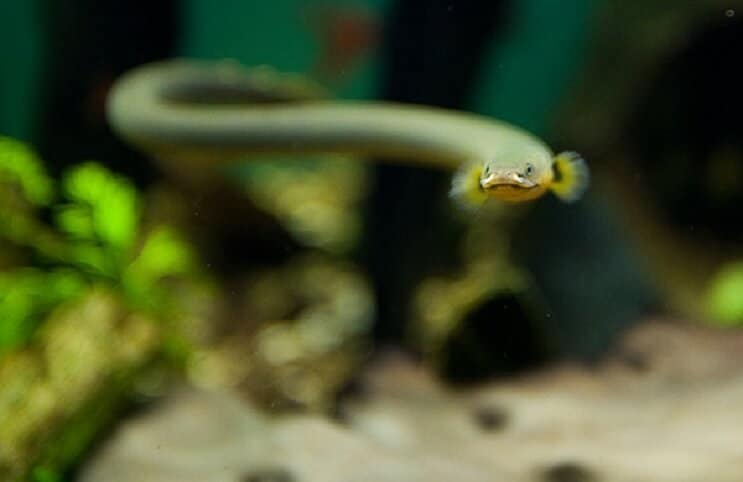
This is a peaceful species so there are plenty of options when choosing some tank mates. You just need to bear a few things in mind.
Firstly, being a predator means they will eat fish if they’re hungry, even though this isn’t their main food source in the wild. They won’t be able to distinguish between the foods you give them and any snack-sized tank mates.
Small fish like tetras, danios, and harlequins will start to disappear. Any fish you do keep need to be larger than a rope fish’s mouth so that they can’t be eaten.
A few good examples include Angelfish, Bala Sharks, Clown Loaches, Dwarf Gouramis, Glass Catfish, Pictus Catfish, Plecostomus, Rainbow Sharks, Siamese Algae Eaters, and Yo-yo Loaches.
Another thing to consider is the temperament of the tank mates. Aggressive, territorial species will harass the rope fish. Aggressive cichlids (such as Convicts and Oscars) should be avoided.
You should also avoid adding invertebrates. Small shrimp and snail species will be treated as food. Some people actually choose to add these into the tank as part of their diet (more on this later).
Keeping Rope Fish Together
You can keep these fish either on their own or in a group. Some people think that they’re more active in small groups, but a group takes up more space, so make sure you can comfortably fit a group in your tank before purchasing.
Diet
Rope fish are carnivores. In the wild, they would eat crustaceans, insects, and worms. They also eat fish, but this is usually the last choice.
This means that they will eat small fish in your tank, so you need to be careful with your tank mate choices.
They’re nocturnal creatures, resting in the day and feeding at night. They’ll quickly learn your feeding routines though and can start feeding during the daytime.
Though they don’t eat vegetation, there are still lots that you can feed them.
Usually, the easiest options are store-bought flake and pellet foods, but this species doesn’t always accept dried foods.
Meaty frozen foods are the best choice. Smaller fish will happily eat bloodworms, brine shrimp, and mosquito larvae. Once they’re a little bigger you can move onto larger shrimps (like Mysis Shrimp), prawns, and even earthworms.
Live foods can be introduced too. They’re a bit more engaging for your rope fish and encourage some natural behaviors.
They rely heavily on their sense of smell to find food. This sometimes means that they go hungry if they’re in a tank with other meat-eating fish.
Feed them just before you turn out their light.
They can go long periods without food in the wild but should be given a steady diet in captivity. You could choose to give them a little bit of food every day (e.g. 1-2 shrimp) or give them larger portions (e.g. 2-4 shrimp) every other day.
Care
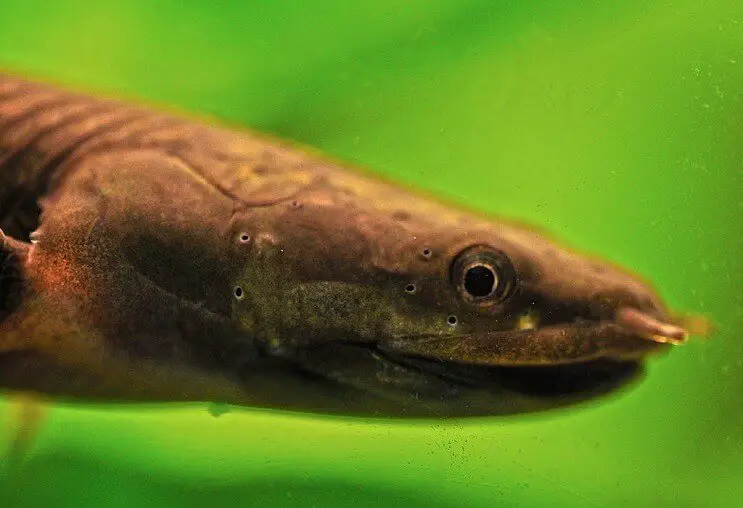
It can be daunting to purchase a fish like this. They look different to ‘normal’ fish, so you might think that they’re hard to care for. This isn’t true; we’ve already discussed how they have similar needs to most species. A well setup tank should keep them healthy.
They’re a hardy species, accommodating a range of conditions and proving resistant to disease.
They don’t cope well with changes in water conditions though, once they are acclimatized to your tank you need to maintain their environment.
There are usually many ways to spot illness in your rope fish, symptoms will vary depending on the disease but there are a few common ones.
Behavioral changes (such as a loss of appetite or reduced movement) start as the disease takes control. Changes in color or strange markings and wounds can indicate disease too.
Ich is a common problem, this presents as white spots on the scales.
Adding salt into the aquarium is used to reduce infections. You need to add an amount of salt so that you have two tablespoons per five gallons of water. The key to doing this is adding the salt slowly over 1.5-2 weeks so you don’t send your fish into shock.
There are many treatments you can buy from stores for various diseases, including Ich.
Breeding
Successfully breeding this species in captivity is almost unheard of and unlikely to happen without hormone injections.
If you’re going to give this a try, then raising the temperature slightly and adding more tall plants (like Water Wisteria) might help to encourage breeding.
To court, a male and female will swim around the tank together. Once the female is ready they’ll sit motionless while the eggs are fertilized. The eggs are adhesive and will stick to plants and decorations.
The juveniles hatch after 70 hours. They don’t start feeding until three weeks old; they hatch with a yolk sac to nourish them until then.
If you manage to get to this stage, it’s probably best to separate the juveniles so that they’re not eaten.
Are Rope Fish Suitable For Your Aquarium?
You can’t add these fish into any old tank, there are a few things you need to consider.
The main limitations are tank mates. If you have small fish, then they will soon be eaten. Rope fish need large, peaceful tank mates that won’t fit in their mouths as a snack.
In the wild, they can be found in African rivers that contain lots of other tropical fish species. Consequently, rope fish prefer water conditions typical of other popular aquarium fish too.
If you find that you can’t add them into your pre-existing tank, it won’t be difficult to design a new one around them since they have similar needs to other species.
It’s worth trying to keep these fish, you will be entertained as you watch them slither around the bottom of your tank.
What attracted you to keeping Rope Fish? Let us know in the comments section below…

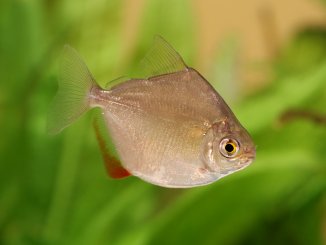
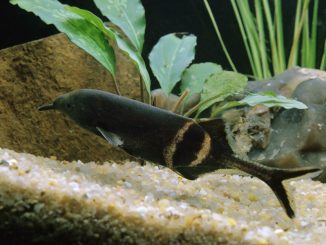
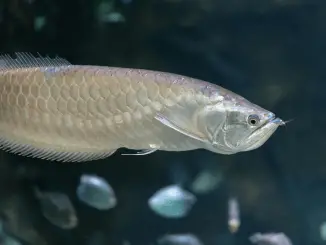
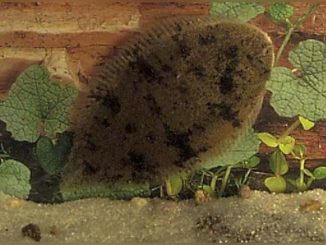
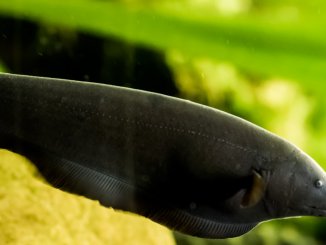
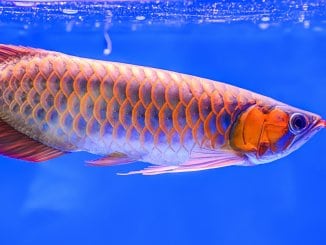
I have rope fish in my 700lt community tank they are the most interesting fish. I have just started cycling a 600lt for Brackish water will be keeping scats archers gobys will the ropes be happy in there?
They can be kept in mildly acidic water, limit salinity to 1.020. The tank size and tank mates are all fine too. Thanks, Robert
They are similar to the khuli/weather loach family also there diet is a exact match;Rasabora tetras,flame tetras&congo tetras all have the same type of diet!(I’ve also seen about 4 in my cousins 20 gallon tank!)
I only wonder how they get caught and why there isnt a video on the internet showing it
someone should go there to see how its done ;)
I was wondering if they could be kept in a tank with dojo loaches. Is that possible. I also have a 7 inch pelco.
Will they eat adult bamboo Shrimp?(they can grow up to 2-3 in length)
Today I saw a pair in a local aquatics store at the city. I actually wanted to buy a new betta splendens for my aquarium, which is pretty much a wild mix of everything I liked and lived long enough to share the same tank eventually. I had 2 tanks before, now I have a single big one. I thought “Hey an eel? It looks cool, come, let’s get one!” (The data to care for it was on the aquarium, and in my language it’s literally called fin eel, so I did not really get it was a long fish at first) Well now I bought it and put it into a tank with around 250L and 2 bettas, 3 corys, 3 ancistrus, guppies – too many; gotta reduce and he’s my way, 4 neons and 3 ground fish I don’t know the non german name of, silver catfish with black Ys.
I’ve had aquariums since like 4 to 5 years and this mix actually and weirdly works well. Now “Buddy” joined my aquarium. Buddy likes chin scratches.
We have a rope fish, it’s such a character and funny to watch.
It has escaped once so have to keep all possible escapes routes closed off and the water level slightly lower than the top of the tank so it makes it more difficult to get out.
Really enjoy keeping this snake looking cheap!
I have 4 rope fish, well at least 5 now. I was vacuuming the gravel and found one about 1 1/2 inch long. So, I guess they can be bred without hormones injected and high temps.
I have a rope fish a little over a yr now, I have neon tetras rafeal cat fish, snail,plecos,blood parrot,hillstream loaches. 125 gallon He dug his way under 1 of my statues.i feed him bloodworms and red wiggler live worm. Alot of everything else he won’t eat. I really want another 1 to friend um.He loves alot of plants especially the 1s that float. My blood parrot always steals his food so I have to make sure I feed bloodworms to blood parrot first. They are fun!
where can i buy ropefish? my local petco/petsmart doesn’t have any :(
Edit – found some at worldwidefishandpets.com